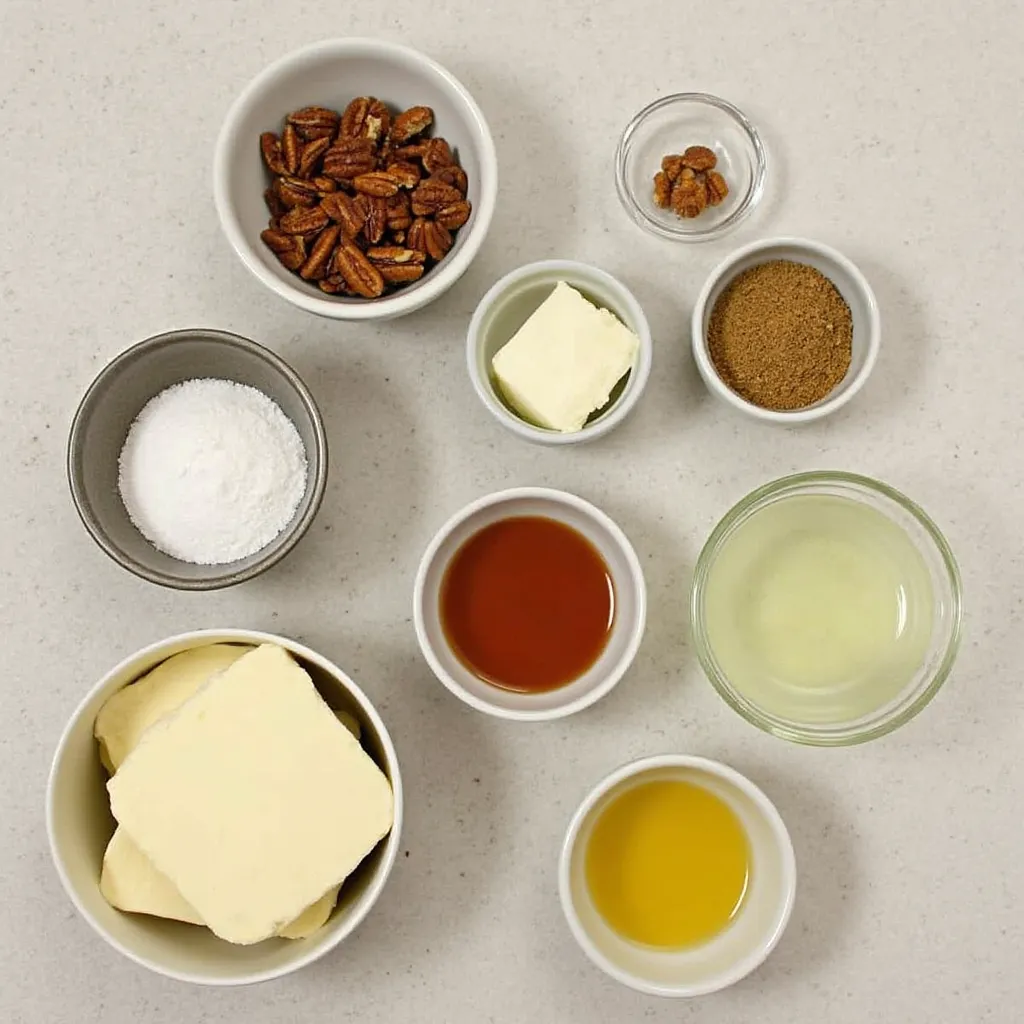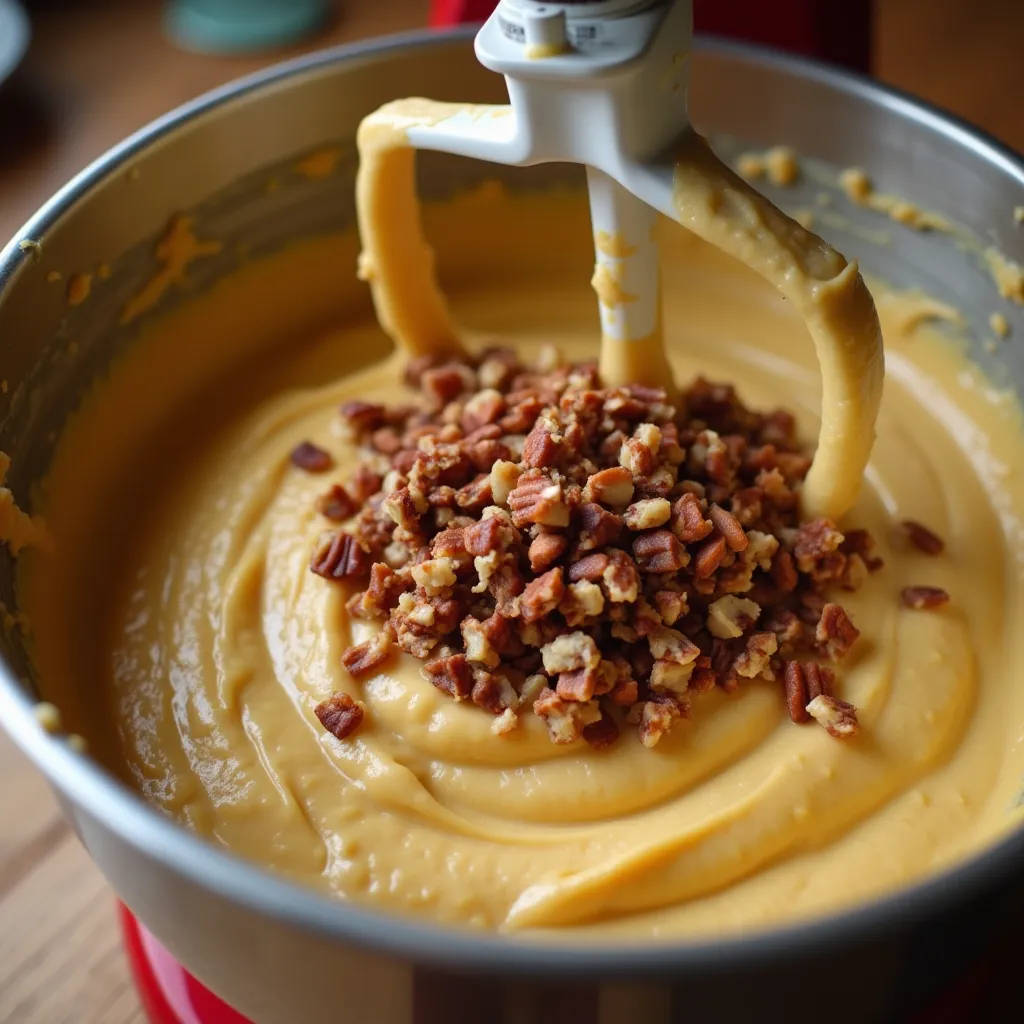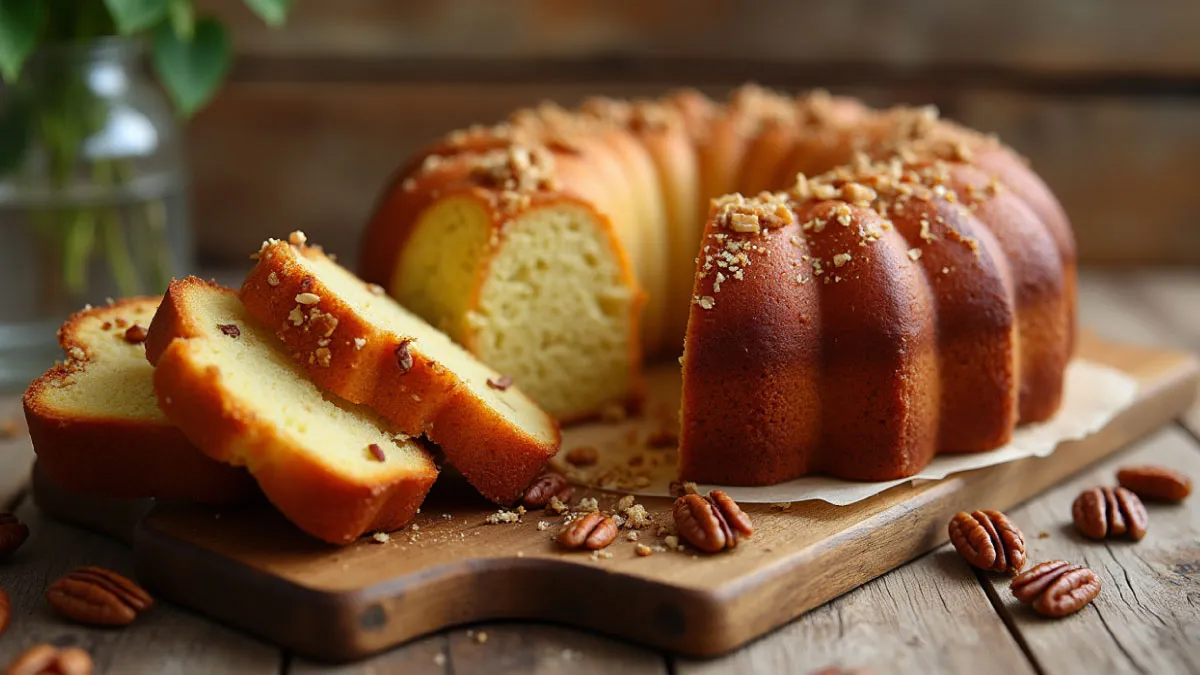Butter Pecan Pound Cake: A Delicious Homemade Recipe Guide
There’s something comforting about a homemade butter pecan pound cake. The rich, buttery flavor combined with the crunch of toasted pecans makes every bite unforgettable. Whether you’re a seasoned baker or just starting, this guide will walk you through everything you need to know.
You’ll learn the history behind pound cake, why butter pecan is such a beloved flavor, and how to bake the perfect cake from scratch. We’ll also share variations, expert tips, and answers to common questions. Let’s get started!
Table of Contents
Introduction to Butter Pecan Pound Cake
What is Butter Pecan Pound Cake?
Butter pecan pound cake is a rich, dense cake with a deep buttery taste and crunchy pecans baked right in. It follows the traditional pound cake formula but adds a nutty twist. The texture is soft yet firm enough to slice neatly, making it perfect for desserts, snacks, or special occasions.
Most recipes use sour cream or cream cheese to keep the cake moist. Some bakers drizzle a glaze on top, while others prefer a dusting of powdered sugar. However you make it, this cake is a true Southern classic.
The History of Pound Cake and Its Southern Twist
Pound cake dates back to the 1700s when bakers used equal parts butter, sugar, eggs, and flour—each weighing a pound. Over time, the recipe evolved. Bakers started adjusting ingredients to improve texture and flavor.
In the South, pecans became a popular addition, giving the cake a nutty crunch. Combined with butter, this flavor became an instant favorite. Today, butter pecan pound cake is a staple at family gatherings, holiday dinners, and Sunday brunches.
Why Butter Pecan is a Popular Flavor Combination
There’s a reason why butter pecan is used in ice cream, cookies, and cakes. The mix of creamy butter and toasted pecans creates a deep, caramel-like flavor. When baked into a pound cake, it adds warmth and richness that’s hard to resist.
Toasting the pecans before adding them to the batter brings out their natural oils, making them even more flavorful. The result? A cake that’s buttery, nutty, and incredibly satisfying.
Ingredients and Tools You Need
Baking a butter pecan pound cake starts with gathering the right ingredients and tools. A well-prepared kitchen makes the process smoother and guarantees better results. Let’s go over everything you need before mixing up this delicious cake.

Essential Ingredients for Butter Pecan Pound Cake
Every ingredient in a butter pecan pound cake plays a key role. The butter brings richness, the sugar adds sweetness, and the pecans give a satisfying crunch. Below is a breakdown of what you’ll need.
| Ingredient | Quantity | Notes |
|---|---|---|
| Unsalted butter | 1 cup (2 sticks) | Room temperature for easy mixing |
| Granulated sugar | 2 cups | Creates sweetness and texture |
| Brown sugar | 1/2 cup | Adds a caramel-like flavor |
| Eggs | 4 large | Room temperature for better consistency |
| All-purpose flour | 3 cups | The base for the cake structure |
| Baking powder | 1/2 teaspoon | Helps the cake rise slightly |
| Kosher salt | 1/4 teaspoon | Balances sweetness |
| Sour cream | 1 cup | Keeps the cake moist and soft |
| Vanilla extract | 2 teaspoons | Adds depth to the flavor |
| Chopped pecans | 2 cups | Toasted for extra flavor |
Some bakers like to add a butter pecan glaze on top, which typically includes butter, powdered sugar, and milk. This optional topping makes the cake even more indulgent.
Necessary Baking Tools
The right tools make baking easier and help you avoid common mistakes. Here’s what you’ll need:
- Loaf pan or bundt pan – Either works, but a bundt pan gives the cake a more elegant look.
- Electric mixer – Helps blend the butter and sugar until light and fluffy.
- Mixing bowls – You’ll need at least two—one for dry ingredients and one for wet.
- Measuring cups and spoons – Accuracy is key to getting the best results.
- Cooling rack – Allows the cake to cool evenly and prevents it from becoming soggy.
Now that you have everything ready, it’s time to start baking!
Step-by-Step Baking Instructions
Now for the fun part—baking the perfect butter pecan pound cake. Follow these steps closely for a moist, flavorful cake that’s packed with buttery goodness and crunchy pecans.
How to Toast Pecans for Maximum Flavor
Toasting pecans brings out their natural oils and makes them extra crunchy. Here’s how to do it:
- Preheat your oven to 350°F (175°C).
- Spread the pecans on a baking sheet in a single layer.
- Bake for 5-7 minutes, stirring halfway through to prevent burning.
- Let them cool before adding them to the batter.
This small step makes a big difference in the final taste.
Mixing the Batter Properly
A well-mixed batter leads to a cake with great texture. Here’s how to do it:
- Cream the butter and sugars – In a large mixing bowl, beat the butter, granulated sugar, and brown sugar together until fluffy. This takes about 3-5 minutes.
- Add the eggs one at a time – Beat well after each egg so they mix evenly.
- Mix in the vanilla extract and sour cream – These add moisture and richness.
- Combine the dry ingredients – In a separate bowl, whisk together the flour, baking powder, and salt.
- Gradually add dry ingredients to wet ingredients – Mix on low speed until just combined. Overmixing can make the cake dense.
- Fold in the toasted pecans – Stir gently to keep them evenly distributed.

Choosing the Right Baking Pan
Your choice of pan affects how the cake bakes. A bundt pan gives a classic pound cake shape, while a loaf pan makes it easier to slice. If using a bundt pan, grease it thoroughly to prevent sticking.
Baking Tips for a Perfect Pound Cake
- Preheat the oven to 325°F (163°C).
- Pour the batter into the greased pan and spread it evenly.
- Bake for 60-75 minutes – Check for doneness by inserting a toothpick into the center. If it comes out clean, the cake is ready.
- Cover with foil if browning too fast – This prevents the top from burning while the inside finishes baking.
Cooling and Storing the Cake
Let the cake cool in the pan for 10-15 minutes before transferring it to a cooling rack. This helps prevent breakage. Once completely cool, store it in an airtight container at room temperature for up to four days. For longer storage, wrap it in plastic wrap and freeze for up to three months.
Variations and Customizations
One of the best things about butter pecan pound cake is its versatility. Whether you want a richer taste, a different texture, or a fun twist, there are many ways to customize it.
Adding a Glaze or Frosting
A simple glaze can take this cake from delicious to irresistible. Here are two easy options:
- Butter Pecan Glaze: Melt ¼ cup butter with ½ cup brown sugar and ¼ cup heavy cream. Stir until smooth, then drizzle over the cooled cake.
- Cream Cheese Frosting: Beat 8 oz cream cheese, ½ cup butter, and 2 cups powdered sugar until creamy. Add a splash of vanilla for extra flavor.
Either option adds a sweet finish that pairs perfectly with the toasted pecans.
Making It Gluten-Free or Dairy-Free
Want to make this cake accessible to more people? Try these simple swaps:
- Gluten-Free: Use a 1:1 gluten-free flour blend instead of all-purpose flour. Add an extra egg for better structure.
- Dairy-Free: Replace butter with vegan butter or coconut oil, and use coconut yogurt instead of sour cream.
These changes keep the cake moist and flavorful while accommodating dietary needs.
Turning It into Cupcakes or Mini Loaves
If you prefer individual portions, this cake can easily be adapted:
- Cupcakes: Fill cupcake liners ¾ full and bake at 325°F (163°C) for 20-25 minutes.
- Mini Loaves: Divide the batter into small loaf pans and bake for 35-40 minutes.
Both options are great for gifting or serving at gatherings.
For more delicious dessert ideas, check Mounds Bar Cake Recipe for quick and flavorful meal ideas.
Pairing and Serving Suggestions
A slice of butter pecan pound cake is amazing on its own, but the right pairing can make it even better. Whether you’re serving it for breakfast, dessert, or a special occasion, here are some great ideas.
Best Drinks to Serve with Butter Pecan Pound Cake
The rich, buttery taste of this cake pairs well with a variety of drinks:
- Coffee – A hot cup of dark roast coffee balances the sweetness.
- Tea – Try black tea or chai for a spiced contrast.
- Milk – A classic choice that brings out the cake’s creamy texture.
- Bourbon or Brandy – For an adult treat, pair it with a small glass of warm, smooth liquor.
Serving Ideas for Holidays and Special Occasions
This cake is a showstopper for any gathering. Try these festive serving ideas:
- Holiday Dessert Table – Serve it with pumpkin pie and apple crisp for a Southern-style holiday spread.
- Brunch Addition – Pair it with fresh fruit and whipped cream for an elegant morning treat.
- Ice Cream Topping – Warm a slice and serve it with vanilla ice cream for a simple but indulgent dessert.
Storing Leftovers for Freshness
Want to keep your butter pecan pound cake fresh for days? Follow these tips:
- Room Temperature: Store in an airtight container for up to 4 days.
- Refrigeration: Wrap tightly in plastic wrap and keep in the fridge for up to a week.
- Freezing: Slice the cake, wrap each piece in plastic wrap, and freeze for up to 3 months. Thaw at room temperature before serving.
Proper storage ensures every bite tastes as good as the first!
Common Mistakes and How to Avoid Them
Even experienced bakers can run into trouble when making butter pecan pound cake. From dense textures to uneven baking, small missteps can affect the final result. Here are some common mistakes and simple ways to fix them.
Why Your Butter Pecan Pound Cake Might Be Too Dense or Dry
A perfect butter pecan pound cake should be rich but not too heavy. If your cake turns out dense or dry, here’s why:
- Overmixing the batter – Mixing too much after adding the flour develops gluten, making the cake tough. Stir just until combined.
- Not enough moisture – Ingredients like sour cream keep the cake soft. Skipping or reducing them can lead to dryness.
- Wrong oven temperature – Baking at too high a temperature can dry out the cake before the center is done. Always check with an oven thermometer.
- Old baking powder – If your baking powder is expired, the cake won’t rise as expected. Replace it every six months for the best results.
How to Prevent Pecans from Sinking to the Bottom
Nobody wants all their pecans sitting at the bottom of the cake. To keep them evenly spread:
- Toast and cool the pecans – This removes excess moisture, helping them stay in place.
- Coat pecans in flour – Tossing them in a little flour before adding them to the batter helps prevent sinking.
- Use a thick batter – A thicker batter holds mix-ins better than a runny one. If your batter is too thin, check your ingredient measurements.
Getting the Right Baking Time for Your Oven
Every oven is different, and baking times can vary. If your butter pecan pound cake is underbaked or too dark on top, try these tips:
- Check early – Start testing for doneness 10 minutes before the recipe’s suggested baking time.
- Use the toothpick test – Insert a toothpick into the center. If it comes out clean or with a few crumbs, the cake is ready.
- Cover with foil if browning too fast – If the top darkens too quickly, loosely tent the cake with foil to slow browning while it finishes baking.
These simple fixes can help you bake a perfect pound cake every time!
Frequently Asked Questions
What is the difference between a butter cake and a pound cake?
Both cakes use butter as the main fat, but they have key differences. Butter cake has a lighter texture because it includes more leavening agents like baking powder or baking soda. It’s soft, fluffy, and typically made with a higher liquid content.
On the other hand, pound cake is denser and richer. The classic recipe uses equal parts butter, sugar, eggs, and flour, creating a firm yet moist texture. Pound cakes are usually baked in loaf or bundt pans and don’t rely as much on leavening agents for rise.
Is it better to use cake flour or all-purpose flour for pound cake?
All-purpose flour is the best choice for butter pecan pound cake. It has the right amount of protein to provide structure while keeping the cake tender.
While cake flour makes cakes soft and airy, it can make pound cake too delicate, causing it to crumble. If you only have cake flour, mix it with a little cornstarch to increase its strength.
Is it better to bake pound cake at 325°F or 350°F?
Baking at 325°F (163°C) is best for pound cake. A lower temperature allows the cake to bake slowly, giving it an even texture without drying out the edges.
Baking at 350°F (177°C) works for some cakes but can lead to a crust that forms too quickly before the inside is fully baked. Stick with 325°F for the best results.
Why is a cold oven the secret to a better pound cake?
Some bakers swear by the cold oven method, where the cake is placed in the oven before preheating. As the oven warms up, the slow temperature increase allows the cake to rise gradually, creating a finer crumb and better texture.
However, not all recipes work well with this method. Traditional pound cakes with no added leavening agents benefit the most. If your recipe includes baking powder, it’s best to use a preheated oven.
How do I keep my pound cake from being dense?
A pound cake should be rich, but not overly heavy. To avoid a dense cake:
Cream the butter and sugar well – Beat until light and fluffy to trap air in the batter.
Use room-temperature ingredients – Cold butter or eggs won’t mix properly.
Measure flour correctly – Too much flour makes the cake dry and dense. Spoon and level it instead of scooping.
Don’t overmix – Stir just until combined after adding the flour to avoid developing too much gluten.
Can I use margarine instead of butter for pound cake?
You can, but it won’t taste the same. Butter gives butter pecan pound cake its signature flavor and rich texture. Margarine contains more water and less fat, which can lead to a softer, less flavorful cake. If you must use margarine, choose one with at least 80% fat content for the best results.
Final Thoughts
Baking a perfect butter pecan pound cake is easier when you understand the right techniques. From choosing the right flour to baking at the correct temperature, small details make a big difference.
This cake isn’t just a dessert—it’s a tradition. Whether you’re making it for a holiday, a family gathering, or just because you love the flavor, every bite is worth the effort. Follow these tips, and you’ll have a moist, flavorful cake with the perfect balance of butter and pecans.
Now that you’re armed with all the knowledge you need, it’s time to get baking. Enjoy your homemade butter pecan pound cake, and don’t forget to share it with those you love!
